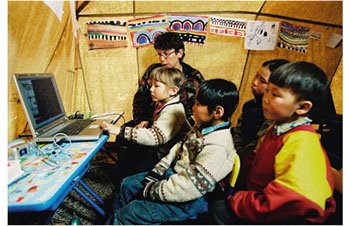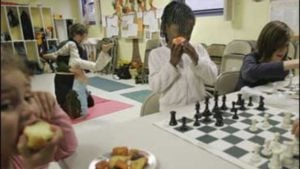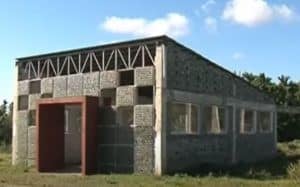Although the United Nations classifies education as a human right belonging to every child, about 100 million children worldwide face barriers, sometimes seemingly insurmountable ones, that keep them from going to school. Environmental problems like climate change, storms, floods, natural disasters, and energy shortages make educating the poor difficult in many areas of the world.
Fortunately, schools are not limited to rows of desks, stacks of textbooks, and linoleum hallways. They can be caves, boats, or train platforms. Yes, there’s a whole world of unusual and amazing schools out there!
.
 Boat schools, Bangladesh
Boat schools, Bangladesh
Many children in rural Bangladesh, particularly girls, do not have access to education. Due to tradition, boys are the first to be sent to school, and girls can go to school only if the facility is not too far from home. Often, the nearest school is miles away; for girls, this can represent an insurmountable challenge to their schooling. During the monsoon season, many schools find themselves under water. Due to climate change, the yearly floods have become worse and prolonged, and children can now go for months without having classes.
The solution by the nonprofit Shidhulai was unusual but simple and effective: If children can’t go to school, the school in the form of boats should go to them.
.
 Train platform schools, India
Train platform schools, India
As a schoolteacher, Inderjit Khurana used to take the train to work. And each day, in the stations, she would come into contact with dozens of children who spent their days begging from train passengers rather than attending school. She learned that it was not a rare or isolated problem and that millions of children in India live on the streets.
Convinced that these children would never be able to escape their conditions of poverty and homelessness without education, and realizing that it would be impossible to enroll these children in school, Inderjit created a model program for “taking the school to the most out-of-school children.”
Khurana’s “train platform schools” aim to provide a creative school atmosphere and equip children with the basic levels of education necessary to work productively, enjoy many of life’s pleasures, and become positive contributors to their communities.
.
 Cave school, China
Cave school, China
Dongzhong was an elementary school located in Miao village, China’s Guizhou province. The strange thing about this learning institution was that it was housed by a giant cave carved inside a mountain over thousands of years, by wind, rain, and earthquakes. The locals put together a small structure, but children attended classes protected only by the cold walls of the cave.
Guizhou is one of the poorest provinces in China. Water and food shortages caused by desertification and drought have left the region regularly struggling to keep its people alive.
The lack of everything else needed to live has also translated into a lack of educational resources. For most children in the province, schooling is not an option.
With little to no support available from the government, the Miao people decided to take education into their own hands. Lacking resources to build, they decided to make one cave into their elementary school, aptly naming it Mid-Cave Primary School. Dongzhong was opened in 1984, employing eight teachers to teach 186 students.
However, the ingenious plan was met with derision by Beijing, who ordered the school to be shut down. A government education spokesman said the school had to close because “China is not a society of cavemen.”
.
 Nomadic school, Siberia
Nomadic school, Siberia
In south-eastern Siberia, a nomadic group is trying to preserve their way of life. The traditional culture of the Evenk, who excel at reindeer herding, hunting, and fishing, has been eroded through contact with Western civilization.
The authorities decided late in the 1960s that Evenk children should follow the regular school curriculum, even if this meant that for months at a time, year after year, the children had to attend state boarding schools far from their families and nomadic life.
For eight years, Alexandra Lavrillier, a brilliant French ethnologist, has been helping them to save their heritage by setting up a nomadic school that will give Evenk children a chance to receive a modern education while maintaining their ancestral traditions.
Lavrillier’s nomad school has been up and running since the start of 2006 and was granted the status of “official experimental school,” recognition that may pave the way for similar experiments elsewhere in Siberia.
.
 School in the clouds, China
School in the clouds, China
Children living in the Gulu Village, a mountainous region in China’s Sichuan Province, used to have to walk on foot along a very long and treacherous mountain path to get to Gulu Village Primary, a school hidden in the middle of the clouds.
The school’s one lone teacher, Shen Qijun, had been laboring in love for 26 years. Shen came to the school when he was 18 years of age. Back then, the classrooms were built with mud, the rooftop leaked, the walls were cracked, and there was no restroom. A student had a bad fall and sustained an injury while looking for a restroom. So Shen gathered the villagers to help rebuild the school the old-fashioned way.
The new school, built from concrete, had five classrooms and a restroom. A basketball court was built in front of the school with an abandoned blackboard and two wooden posts. Boys would play carefully with the basketball, not daring to shoot; otherwise, they would have to spend half a day bringing the ball back from the foot of the mountain.
No one outside the village knew about this remote school until a newspaper report was published three years ago. Donations poured in after that to help the children settle in schools in the town below the mountain.
.
 Turning child brides into scholars, Kenya
Turning child brides into scholars, Kenya
Imagine being born into a society where, before you ever take your first breath, someone — probably older than your father — has already claimed you as his bride. Your freedom and your ability to pursue love are traded for a few cattle heads. Yet, for countless babies and girls in Kenya’s Maasai tribe, being “booked” for marriage before birth is simply a fact of life.
The Naning’oi Girls’ Primary School was founded in 1999 to rescue underage girls “booked” for marriage, and instead, “book” them for school. The program’s brilliance is that it uses the familiar process of offering a dowry to a girl’s father (in the form of donated livestock and gifts) to secure the girl’s release to the school. In essence, the school becomes the child’s “husband,” and she is sent to live and study with other girls in the boarding school.
Margery Kabuya has worked tirelessly on the Naning’oi boarding school program since its inception, and has seen enrollment rise from just four students in 1999 to nearly 350 boarders.
.
 Underground school, New Mexico, USA
Underground school, New Mexico, USA
Abo Elementary School in Artesia, New Mexico, was the first public school in the United States constructed entirely underground and equipped to function as an advanced fallout shelter.
Designed at the height of the Cold War and completed in 1962, the school had a concrete slab roof that doubled as the school’s playground. In addition, it contained a large storage facility with room for emergency rations and supplies for up to 2,160 people in the event of nuclear warfare or another catastrophe. The building was listed on the National Register of Historic Places in 1999.
Within Artesia, Abo Elementary School was lauded by teachers and many parents. Teachers often described Abo’s students as less likely to cause trouble, more attentive, and less likely to require discipline. Yet, many of those same students expressed heightened awareness of the possibility of nuclear war, and some were terrified that they could be orphaned in the event of war. One of the most substantial fears raised by students involved the 2,160-person capacity of the school. In the event of a war, only the first 2,160 people would be allowed into the school for shelter; this would likely have left the majority of Artesia’s nearly 12,000 residents, including the parents of some of Abo’s students, without protection in the event of a nuclear attack.
Outside of Artesia, Abo Elementary School was condemned by many councils and groups, some of whom rejected the concept of an underground school entirely. Notwithstanding, the President of Artesia’s Board of Education, C.P. Bunch, called the school “more a matter of insurance than fear” and expressed hope that future schools built in Artesia would follow its example.
Federal studies concluded that the students suffered no long-term effects from their time in Abo. In addition, many students who suffered from chronic allergies or asthma were transferred to Abo as its advanced air filtration systems reduced the impact of dust storms and allergens. Indeed, these studies concluded that many students’ health improved due to their extended time in this school.
.
 The free school, Brooklyn
The free school, Brooklyn
“Free schools,” which had their heyday decades ago, operate on the belief that children are naturally curious and learn best when they want to, not when forced to. Today, the approach is getting another look from some parents and students tired of standardized testing, excessive homework, and overly rigid curriculums in regular schools.
One recent day at the Brooklyn Free School, the “schedule” included the following: chess, debate, filming horror movies, and making caves for Teenage Mutant Ninja Turtles.
Not that the students had to go to any of these sessions. At this school, students don’t get grades, don’t have homework, don’t take tests, and don’t even have to go to class. Unless they want to.
The Democratic Meeting is the heart and soul of Brooklyn Free School. Once a week, the entire school comes together to make announcements, give props, voice concerns, and work together to take responsibility for the governance and well-being of our school. Students chair meetings. Except for health and safety issues, all students and staff have an equal vote in decision-making at school.
.
 The green roof art school, Singapore
The green roof art school, Singapore
One of the most amazing green roofs in the world is at the School of Art, Design and Media at Nanyang Technological University in Singapore.
Completed in July 2006 at the cost of $38 million, it officially opened in April 2009. Today, it is regarded as an icon of sophisticated design and architecture, and has featured in various international design publications
From a distance, you can barely even tell that the 5-story structure is a building; it blends in so well with its environment. A plethora of glass walls allows plenty of natural light to illuminate the interior, and the grassy roof is used as a meeting space for students. The green roof also insulates the building, cools the surrounding air, and harvests rainwater for landscape irrigation.
.
School designed by kids, Berlin
Feel no sympathy for any kid in Berlin who complains about school if their school is Erika Mann Elementary School. Not only do the principles of their school seem like they were actually created for children, the school’s recently revamped environment is also amazing – perhaps not surprisingly as it was designed by the kids themselves with Baupiloten, a group of architecture students.
.
 Bottle school, Philippines
Bottle school, Philippines
The Bottle School in San Pablo, Philippines, is constructed entirely from recycled bottles used as a building material. This innovative solution is a new way to rebuild finding how to fight climate change in an ecologically resistant structure.
The materials are cement, steel, and glass. The bottles are tied together with thin nylon ropes and are then stacked tightly into blocks, which prevent the bottles from moving around the application of cement required for the gaps.
.
Edublox offers cognitive training and live online tutoring to students with dyslexia, dysgraphia, dyscalculia, and other learning disabilities. Our students are in the United States, Canada, Australia, and elsewhere. Book a free consultation to discuss your child’s learning needs.
.


